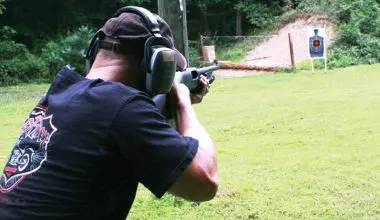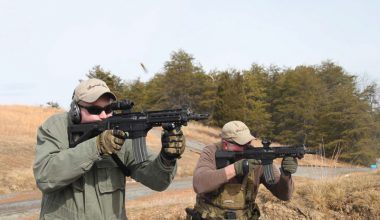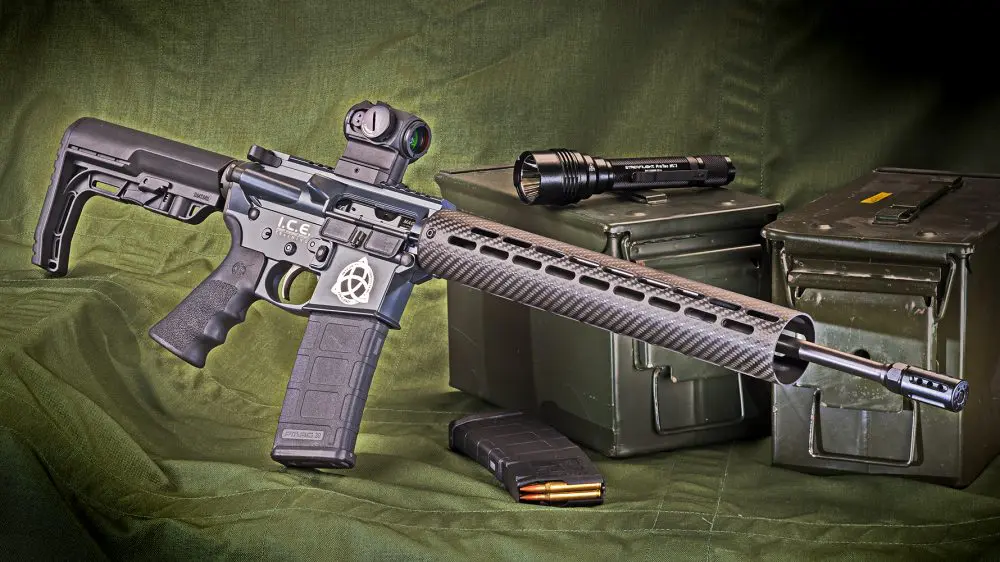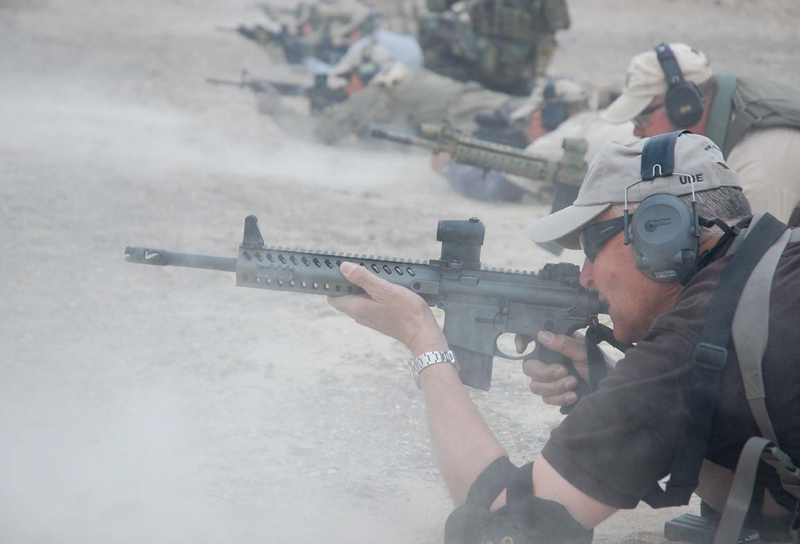

I like the direct-impingement system and have used it in some extreme climates and unfriendly parts of the world. I like the cartridge and have killed everything from mice to moose, and including an irate Alaska brown bear, with M16s. Put a quality bonded bullet in a clean gun and you have no problems that can’t be resolved out to reasonable distances.
OIL AND SAND
One of the few weak points in the M16 series, however, is that they run better wet. I’ve seen specs calling for six drops of oil, carefully placed, that will allow the gun to run perfectly. My experience shows that for most guns, it’s more like 60 drops, which becomes a real problem in both the desert and the Arctic.
During my career with the Alaska State Troopers, our SOP for our SWAT M16s was to totally degrease them on October 1st. The rule of thumb in Fairbanks is 20 below by Halloween—an oily gun freezes solid at that temperature. The hammer may not fall and the oil in the firing pin channel gums up, so even a good hammer strike won’t force the firing pin forward.
After a thorough cleaning, we used brake cleaner to get all the oil off. We found that we could fire four or five magazines on full auto before the guns got too hot. Since most of our shootings took far fewer rounds than that, we ran the guns dry until April.
Sand and dust cause the opposite problem: they can stick to oily bolt groups to an extreme extent. After-action reports from Iraq have shown that the talcum- powder dust makes the M4 perfect for practicing malfunction clearances. One result of the problem was the advent of piston guns, although they have problems of their own.
NEXT GENERATION ARMS
In late 2009, I met a young guy from northern Idaho who was building what he said was the world’s best AR. Right! I’d heard that before. What makes this gun so good? He smiled and told me it was sub-MOA accurate, made of all the best components, and ran nearly oil free.
OK, explain that last part. He did, in considerable detail, and offered a T&E gun to prove it. I’ve now been running the dog doo out of two of his guns for a year and a half—and he may be right. Next Generation Arms (NGA) is building sub-MOA carbines that weigh just over six pounds, are beyond milspec, and run mostly oil free.
The prototype gun was called the MP168, after former Delta troop Mike Pannone. Mike has been torturing his original gun far longer than I have, has close to 20,000 rounds through it, and has recorded excellent accuracy and reliability. Mike also did a great review of the X7 (the current designation of the rifle), and you can read his AAR and see video in Defense Review, February 2011, Shooting the Gray Rifle.


Table of Contents
EXTREME WEATHER TESTING
A test gun was sent to Fairbanks for coldweather testing. The timing was right because temps had hit 31 below zero.
Several shooters fired nearly 2,000 rounds through a totally dry gun. They were instructed to try to break it, make it fail. One test was to cold soak the gun, leave it outside for several hours, then bring it inside a warm building. Condensation immediately forms, coating the entire gun with moisture. It was then cold soaked again to see how it works when the water freezes. This cycle was repeated ten times with no failures. It was thrown in the snow, beaten, dropped—no failures. The dust cover pin did break, since extreme cold is hard on fragile metal parts, so NGA redesigned the dust cover pin.
The only complaint was that the aluminum forend is uncomfortable to hold at minus 30.
The same gun was then sent to Las Vegas Metro PD. Any officer could grab it for a test ride as long as they kept track of the ammo and any problems. The range staff reported excellent results as to accuracy and reliability. Senior Instructor Andy Locher particularly liked the ergonomics of the gun: “The forend is especially good— its shape fits your hand. An accurate round count wasn’t kept, but several thousand rounds were fired with no oil and no cleaning.”
X7 COMPONENTS
There are two secrets to the NGA rifle’s performance: top quality components and a ceramic coating on all working parts. I’m a driver, not a mechanic, so I just call all space-age stuff Fairy Dust. The Fairy Dust NGA uses really works, and has the added benefit of making the system much easier to clean (who hasn’t scraped carbon off a bolt?).
I first asked builder Nathan Roads why worry about a highly accurate carbine— who cares? “You should. I want this to be the only rifle you need, able to hit well at 500 yards.”
Military specs call for four MOA accuracy. That’s 20 inches at 500 yards. Most humans are 17 inches from belt to throat and 16 across, so 20 inches at 500 yards is … a miss. Since most policemen can’t jump out of the cruiser with a shotgun, SMG, carbine, and precision rifle, being able to make good hits from 50 to 250 yards is a good thing. When the same gun can be used for CQB, it’s a great thing.
Nathan is using the incomparable Noveske barrel on some models, which allows for the accuracy (NGA also offers an M4 barrel and a pencil barrel for lighter weight).
I am now shooting the final prototype version, the X7. After trying and discarding many different components, from monolithic rail systems to hydraulic buffers, the X7 uses a Vltor stock, extruded buffer spring housing, and Bravo Company USA bolts, bolt carriers, and Gunfighter charging handle.
NGA makes its own sleek, smooth, lightweight forend, which has removable rail segments. Those of us who don’t like a bunch of stuff on the gun are happy. Gear geeks who want to add an espresso machine can add rails to bolt it to.
NGA builds its own uppers and lowers, selector levers, etc, all machined out of top-quality aluminum and stainless steel. The lower has an integral bevel in the mag well, which really helps on speed and tac loads. My test gun uses a midlength gas system and Geissele trigger. This allows a quick, short reset.
NGA offers several options of BUIS, or none, and is busily working on production select-fire guns and silencers. I used one of the early select-fire guns in an NRA select-fire instructor class I taught in Bethlehem, Pennsylvania. In five days, 2,500 rounds were fired through the gun with no cleaning, no lubrication, and no problems.
ACCURACY
With the great trigger and Noveske barrel, my X7 is wildly accurate. The Black Hills ball shot sub-MOA. I tried four different loads of Black Hills Match ammo: 65, 68, 75, and 77 grain. The accuracy testing was done from a bench, with a forend rest and properly sandbagged. I used a Leupold 1.5X5 matte-finished scope in LaRue QD mounts, which I think are the best on the market. And I used the NRA 50-yard zero target with half-inch grid squares.
I don’t consider myself a precision shooter, so I asked SWAT sniper-instructor Rob Boothe to test the gun. Rob was able to shoot sub-MOA groups at 100 yards—five rounds in a quarter-inch at 100 yards! Some will argue that this level of accuracy is not needed and that all triggers should be milspec. If that held true, all of us 1911 shooters wouldn’t have good sights on our pistols and trigger weight would be six pounds.
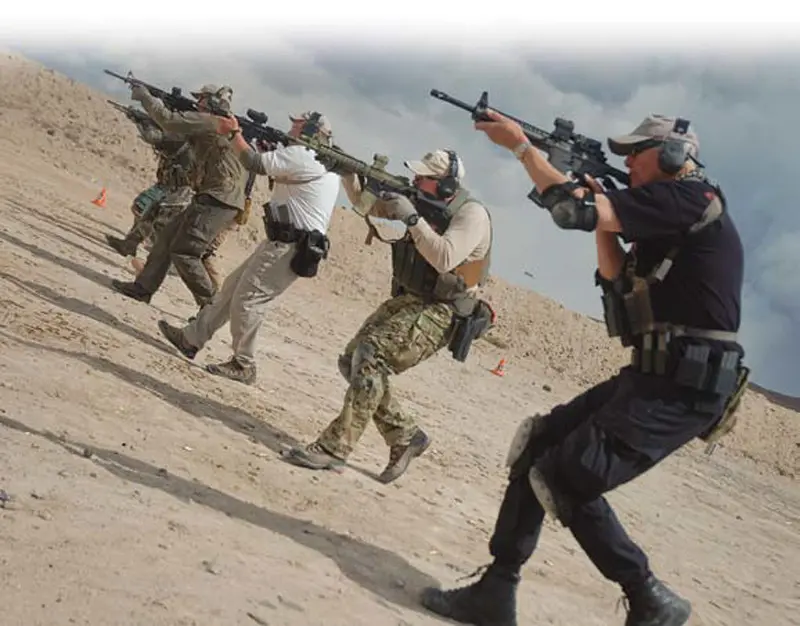

THE TRAINING TEST
It’s pretty hard to self-train and selftest— most of us don’t work ourselves or our gear as hard as we should. To solve that problem, I took the X7 to Reno, Nevada, to spend a few quality days under the nurturing eyes of Pat Rogers and EAG Tactical.
Pat is both a Marine and law enforcement combat veteran, and possibly the least politically correct instructor I’ve ever trained with—thank God. If you want to be coddled and told how well you’re doing, go somewhere else, but it’s exactly the kind of school the X7 and I needed.
Pat’s classes have you humping, with very little sit-on-your-butt time. Each day started with zero verification at 50 from prone. We ran countless drills, all from Pat’s fertile mind, that push the gun and the shooter. Lots of mags ended up in the dirt, then being shoved into the mag well. We rolled around in the dirt, and the constant wind insured dust, dirt and grit got into the receiver.
On the last day, wind speed was 40 knots gusting to 60—and there was sand in everything. The X7, dry, ran like a sewing machine.
I fired 1,250 rounds of quality ball ammo from Black Hills, which helps, but I didn’t clean the gun once. I just wiped the bolt group off each day with a dry rag. The only malfunctions were those that Pat had us set up. I typically clean my guns each night during a class, so I was impressed that the gun never burped.
As a bonus, the host, LMS Defense, has a range complex that duplicates conditions in Afghanistan. Heat, cold, constant wind, dust, sand and rain … perfect. LMS performs combat development for the U.S military and offers a wide variety of training. LMS has 90 acres of ranges surrounded by miles of desert and offers extreme distance shooting and miles of dirt road for desert training.
The gun is not designed to be run constantly with no oil, just minimal oil. I ran it dry as a proof-of-concept. NGA says the gun should be maintained normally and run with four to six drops of oil. After seeing students dump lots of oil into their guns, and having done it myself in other classes, I can verify that this gun is as low-maintenance as it gets.
I used a scope on the NGA X7 for one full day of the class, exploring the Designated Marksman concept. I also used an Aimpoint T-1 with 3X magnifier. The important thing about this is that the X7 performed flawlessly with either optic and at every range we shot.
SPEAKING AS A GUN GUY …
I’m a gun guy. I own, shoot, study, and train with lots of guns, from revolvers to full-auto guns. However, it’s only been in the last few years that I’ve started to realize that more money can buy a better product. “Buy cheap, buy twice.”
It’s true that some space-age materials and manufacturing processes can improve existing systems (even the 1911, which was sent to earth directly from God …). Technology can improve an existing platform and design, and the NGA X7 is a good example.
I currently have six ARs, but I may cull the herd a little and get a couple of the NGA guns. At $2,400 for the gun I tested, the cost is pretty steep. Once in full production, NGA hopes to get the guns out the door for about $1,800.
Jack O’Connor talked about the onerifle rifleman. I’d be happy using this carbine in Alaska to hunt sheep, caribou and deer, and it would be a ball on prairie dogs in Montana. With a Sure- Fire light and Aimpoint T-1 Micro sight, it’d be perfect for things that go bump in the night—and I’d be well equipped if Canada invades.
A carbine like the NGA may actually allow you to be a one-rifle rifleman.


